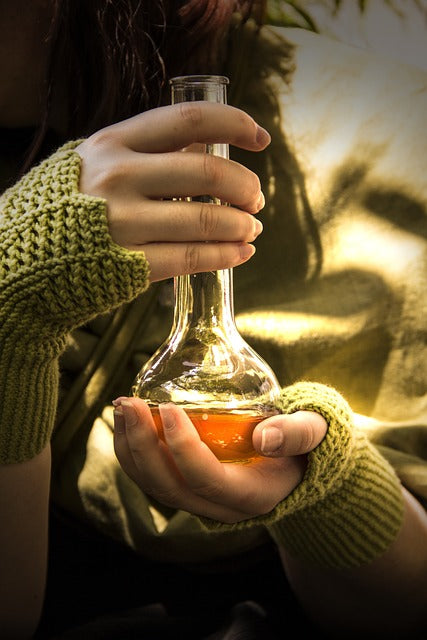Chemical Alchemy

I am always amazed by nature's alchemy; it's pretty magical, a delicate warp and weft that creates the fabric of life. From the moment I first encountered essential oils, I was fascinated...how could a single drop contain such potency to still an agitated, overloaded talkative mind into submission?
It sparked a deep interest and curiosity that has never subsided. One of the elements I find really interesting is the complex chemistry of each oil. The geographic location of origin can affect the composition or unique vibratory signature (this is why lavenders vary so dramatically, they come from many sites and altitudes), nature's alchemy (smile). Most essential oils can have hundreds, sometimes thousands of individual chemical compounds, often included at less than 1%.
The building blocks of these chemical compounds are oxygen, hydrogen and carbon and can be divided into two groups:-
Hydrocarbons - this group comprises terpenes, monoterpenes and sesquiterpenes containing mainly hydrogen and carbon.
Oxygenated compounds - are the second group and made from hydrocarbons by the plant - these are mainly esters, aldehydes, ketones, alcohols, phenols, and oxides. Some oils contain more hydrocarbons, while others more oxygenated compounds. As a general rule of thumb, the oxygenated compounds give the aroma.

The main chemicals are as follows and occur in varying percentages within the composition of essential oils.
Monoterpenes - you'll find these in most essential oils; they're very light small molecules, strong smelling and volatile, and the most prominent chemical family found in many oils - therapeutically stimulating and antiseptic, like Fir Needle, Sweet Orange and Lemon.
Sesquiterpenes - are less common in essential oils; with large dense molecules, they tend to be more stable, less volatile and slower to evaporate. Many of these oils come from roots and woods and have a deeply grounding, balancing effects; Vetiver, Myrrh and Cedarwood.
Alcohols - are plant alcohols and are really common in essential oils. They are one of the most useful in aromatherapy because of their nature. They have a gentle power and fluidity and are blessed with appealing aromas that help assuage emotional and physical pain and repression; think of florals like Rose Otto, Geranium and Neroli.
Phenols - probably the most potent sensitising compounds, highly stimulating and cleansing, taking longer to evaporate with an intense petrol-like aroma; think Clove bud, Basil and Oregano to sharpen and focus.
Aldehydes - have a bright recognisable citrus aroma that identifies this compound, it tends to lack stability and disappears quickly, found in oils like May Chang, Melissa and Lemongrass.
Ketones - are instantly recognised through their minty camphoraceous aroma, which is penetrating and must be handled lightly. It can sometimes be sensitising; however, using it assiduously can alleviate mucus congestion and aid respiration, releasing emotional stuckness; it includes oils like Peppermint, Eucalyptus and Rosemary.
Esters - are one of the most widely present compounds; few oils don't contain them. You can recognise them through their fruity aroma, non-toxic and gentle they can be universally utilised; they are ubiquitously used for their mood-relaxing and balancing properties of oils like Lavender, Bergamot and Chamomile.
Oxides - have a distinctive smell and are a vibrant bracing group with intense aromas offering potent expectorant properties. Oxides are drying molecules that remove dampness from the lungs, making them a perfect choice for respiratory issues. They are found in most Eucalyptuses, also in oils like Rosemary and Niaouli.
And there, we have it, a quick tour of the volatile elements that meld together to create these alchemical wonders; you may think it easy to synthesise them knowing all the compounds, their percentages and composition, but, this is not the case, you would still not have an identical oil and what will be missing would be the therapeutic factor or life force only found in the pure essential oil that nature creates so effortlessly eluding the pretender.
